

The Chrisman family photo album
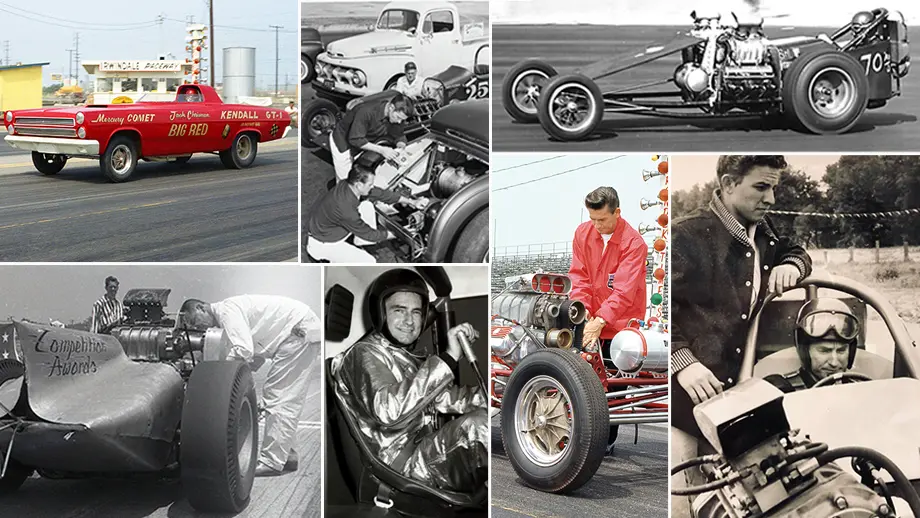
Over its long existence, NHRA Drag Racing has witnessed the rise of many racers who can truly be called the superstars or legends of the sport, and Jack Chrisman is one of them about whom more recent fans might not know, but he was arguably one of the sport’s first true icons.
Chrisman’s name comes to mind, on the eve of the Winternationals, a stage for many of his great moments, through a fortuitous series of email exchanges with his daughter Lana, whom many of you may know as the Executive Director of the fabulous Lions Automobilia Foundation & Museum.
Allow me to explain: While it may be 2024, my brain is already partially engaged for 2026, the season in which NHRA will celebrate its 75th anniversary. I’m deeply immersed in the writing and creation of a spectacular coffee table-style book covering NHRA’s history and a companion book celebrating the Top 75 Drivers of NHRA’s first 75 years.

The big book, which will chronicle the rise of NHRA from concept to reality to international motorsports phenomenon, will be packed with sidebars about notable racers, moments, and technology. One of the featurettes is about the legendary Chrisman family — Jack, brother Everett, nephew Art, son Steve, and, of course, Lana — and I had asked Lana about a specific photo that I wanted to illustrate the piece. She responded with an amazing gallery of photos, many of which I had never seen, so I asked her and brother Steve — he of Top Fuel and Funny Car fame — to share their knowledge and memories of some of those great photos, which include Jack and Art both.
Both Jack and Art Chrisman were so huge in our sport history that they both made our Top 50 Drivers list back in 2000, Jack at No. 23 and Art at No. 29.

“That’s Dad in the middle, Everett on the left, and Lloyd on the right. This is about 1944 when Everett was in the service in World War II — he was an underwater welder — and they’re holding up our dad, who is in a full-body cast after a motorcycle accident. He was 16 in this photo.”
The drag racing branch of the Chrisman family had 14 kids, with Everett the oldest (born in 1901) and Jack the youngest (born in 1928) with 11 sisters between them, and a young brother who died as an infant.
“If you do the math, that means that our grandparents [Henry and Henrietta] had a kid pretty much every other year from 1901 to 1928. Our grandmother was born in 1885, and our grandpa was born 1877, just 12 years after [Abraham] Lincoln was shot.
“A lot of people think that Jack and Art were brothers because they’re only a year apart, but Jack was actually Art’s uncle. Art was a nice guy. If you never met our dad, you could just look at Art. They had the same hand gestures, mannerisms, talked the same. Basically, they grew up together since they were 16."
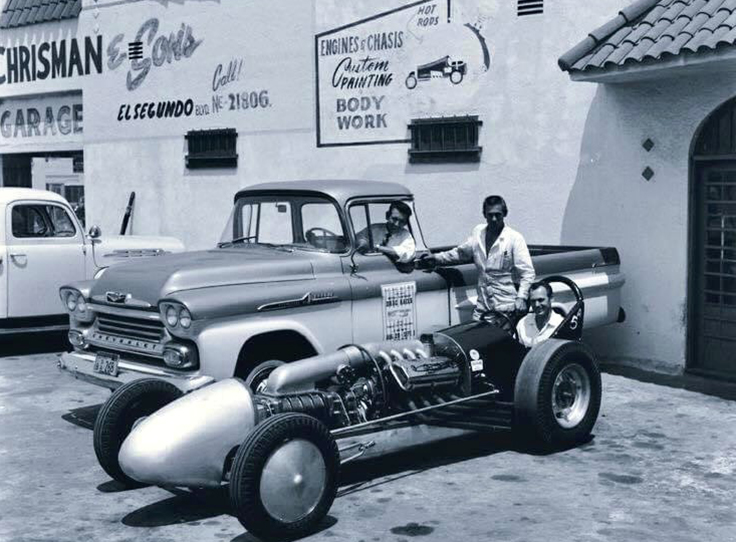
This is the Chrisman & Sons garage in Compton, Calif., that Everett owned and where his sons, Art and Lloyd, worked. That’s the famed Hustler dragster in its early days.
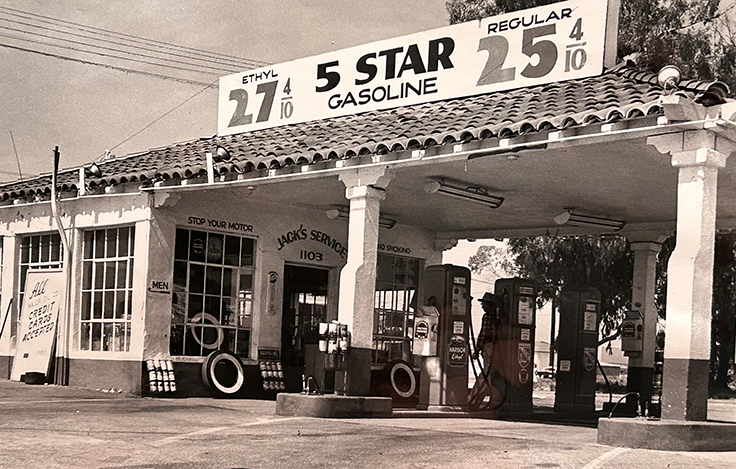
And here’s Jack’s service station, which was next door to the garage.
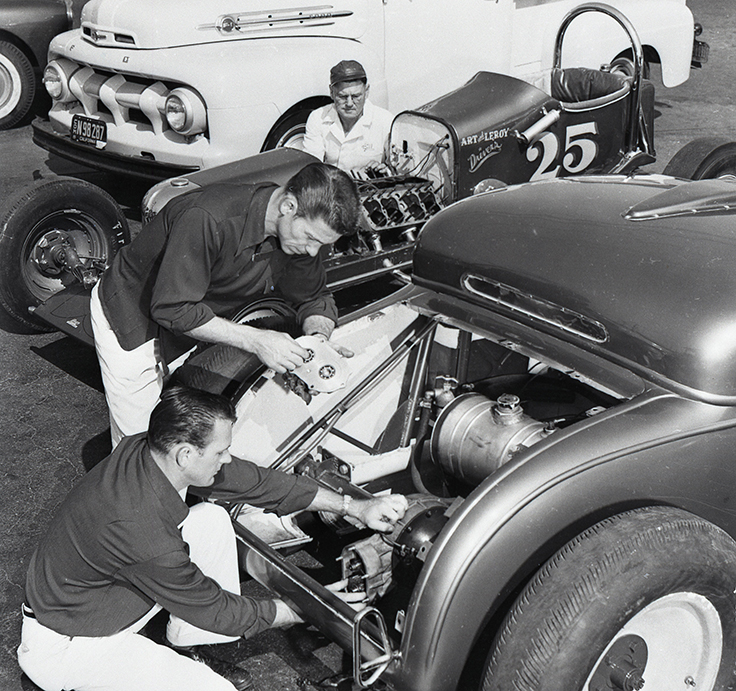
“That's Art’s famous No. 25 car next to Lloyd’s truck. That ended up being Mike Chrisman's truck. At the bottom of the photo working on the rear end, that's Art. Above him was his older brother Lloyd. He was the master mechanic of all the Chrismans. And in the back is Everett.”
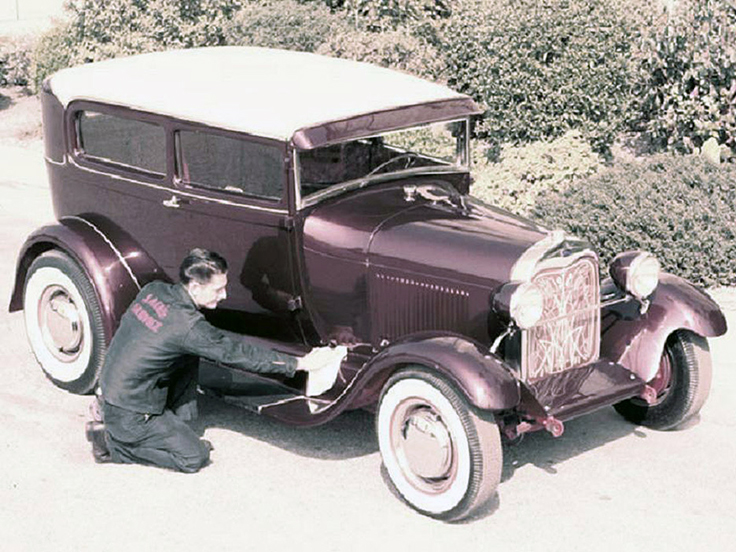
“This was the family’s 1929 Model A that became Dad’s first race car. It was my mom's car that she used to drive back and forth to work. One day, she drove another car, and my dad and Art were hanging out of the shop, and they said, ‘You know what? That thing would sure look nice chopped,’ and Art said, 'Get the hacksaw,' so that night they chopped it, and the next day when our mom come home from work, she asked, ‘What did you do in my car?’ and they said, ‘We made it bitchen looking.'
“They started racing it on nitro, and it ran around 115 mph, and then later on, they put in a 331 Hemi on nitro and it ran 125. This photo, which is probably around 1951, the car still has the flathead. You can tell by the louvers on the side. With the Hemi, they had to make a little knob on the side where the valve covers hit.”
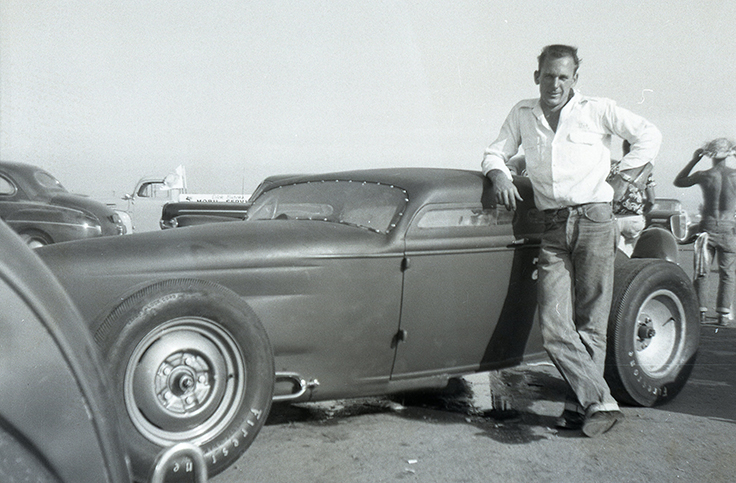
"This is Art's famous coupe, before it was painted. They ran it at the drags and on the salt flats."

“This is Dad's first dragster. They called it 'the purple car.' They bought it from Ed Lusinski, and he ended up putting his 331 Hemi out of the Model A. In those days, nobody kept anything. They just took the motor out of one car and put it in another one. This is probably 1957.” (That’s 3-year-old Steve in the helmet.)

“Our dad drove three different sidewinders in the late 1950 and early 1960s. On No. 1, the crankshaft was in the centerline of the rear axle, and they ran it only on gas. For No. 2, the centerline of the engine was three inches below, so it handled better. This is No. 2, and that's Joe Mailliard tuning. He was a famous tuner back in the day from Long Beach, Calif."

That's Sidewinder No. 2 at Lions. I love the sign: "Fence jumpers will be put out."

“This is the third sidewinder. The engine was laid over at a 45-degree angle and covered by the body. The whole chassis was magnesium. The side panels were all mag, but the front nose was aluminum because they didn't have the mag they could shape like that. Kent Fuller built the chassis, and I think Wayne Ewing [had] done the body. It didn't run very good because it has a weird Volkswagen front suspension on it and it wouldn't handle.”
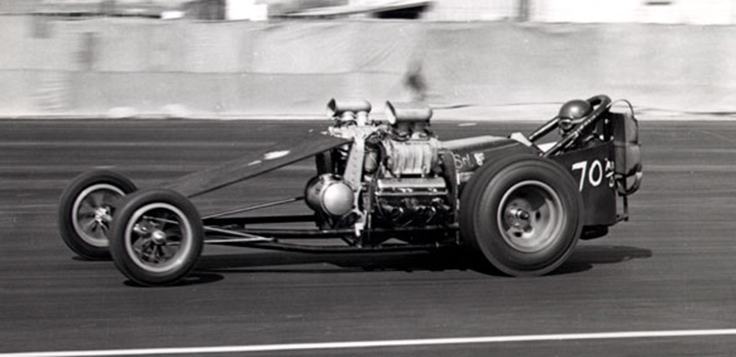
"This is the Howard’s Cam Twin Bears twin-engined car that won the Winternationals in 1961, with that big ol' sheet of plywood up front. The car wanted to wheelstand at the finish line, so the next weekend they had the board on there. Everybody would say, ‘Hey Chrisman, we have to go to the bathroom. Can we borrow your outhouse door?' They laughed, but a lot of people followed and did the same thing."
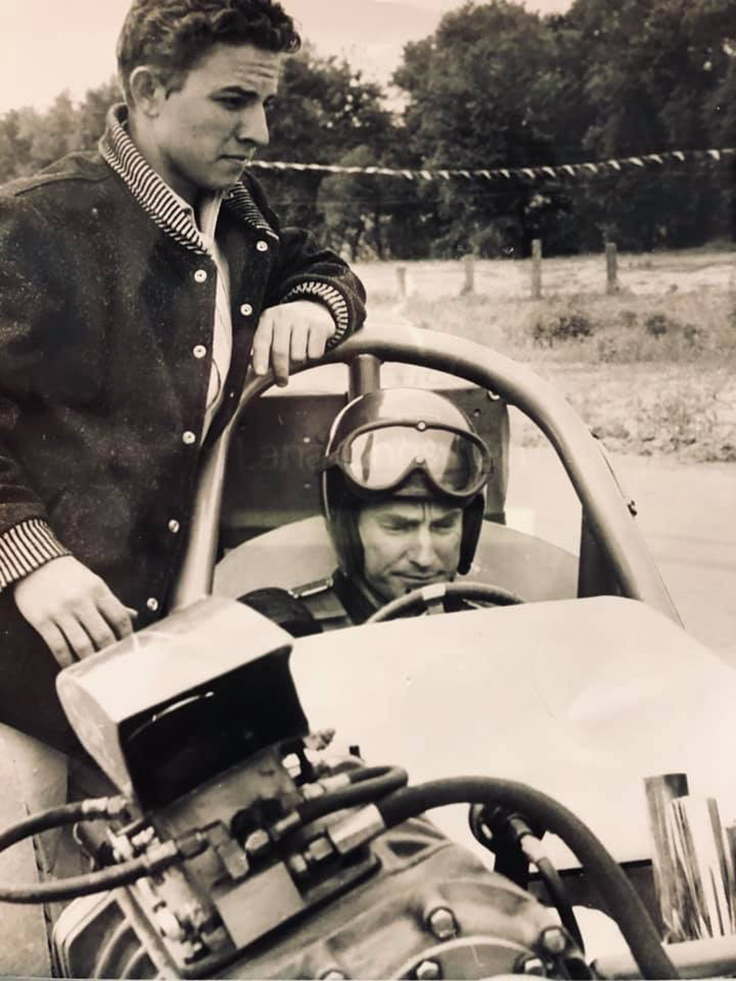
“That’s Jerry Johannsen with our dad. Dad said that was hard to drive at night at Lions because it was so cold, and, because it had no windscreen, if you got hit by a bug, it was like being shot by a gun.”
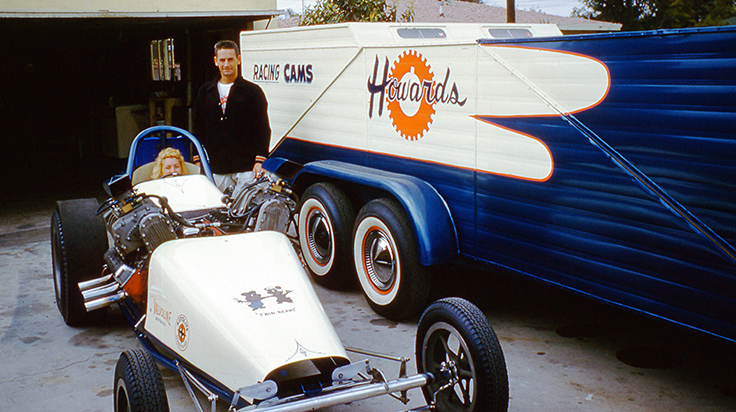
“After they won the Winternationals, they took the car on tour. My mom and dad bent that body up themselves at home, and my dad painted the chassis blue [and] the body white. That was one of the first enclosed trailers in drag racing."
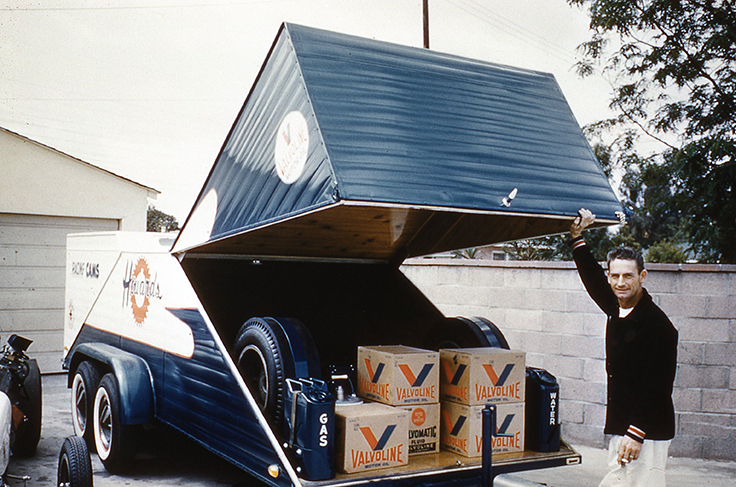
“The trailer would lift up on hinges at both ends, to put the car in and to access your parts. He got a big sponsorship from Valvoline, and they paid him $500 a year, and they painted the trailer for him. You can see you’ve got your oil in there, some kind of gas, and a set of rear tires.”

“They also painted the Twin Bears logo on the new body. The one on the left is Jerry because he has the overalls on, and the other one is our dad because he had the driver's helmet.”
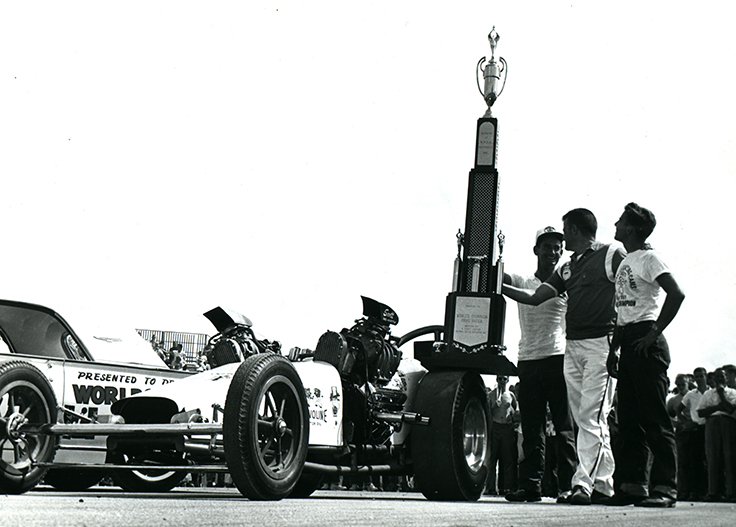
“They ended up winning the NHRA championship that year, which ended at Indy. They got this huge trophy from NHRA and a new Thunderbird from Hurst. Jerry took the trophy and he gave the car to our parents."
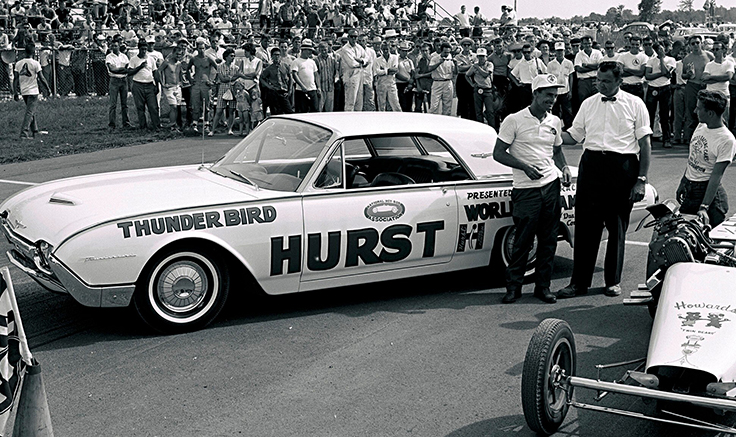
"That’s Dad and George Hurst and Jerry Johansson. Dad got beat by Pete Robinson there in the semi's, but he still won the championship."
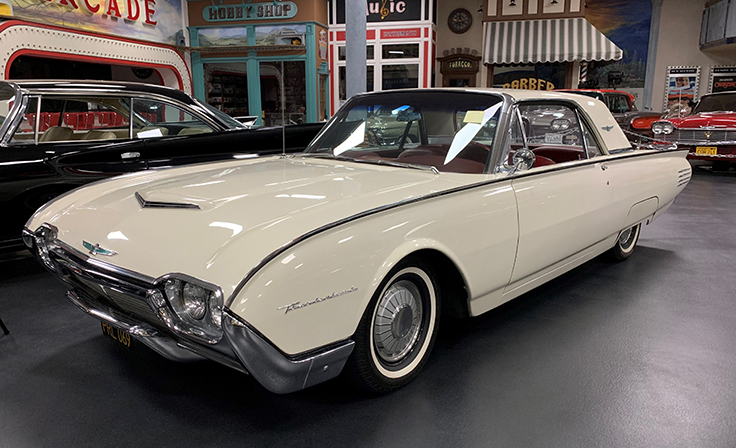
“We still have the Thunderbird. It was in the Lions Museum, but now it’s in Lana’s garage, but it doesn’t have the writing on it anymore. As soon as they [left] Indy, he started white compounding the letters off every time they stopped for gas. By the time they got back to California, all the lettering was off of it, and he handed Mom the keys and said, 'Thank you for helping me win the championship.' "
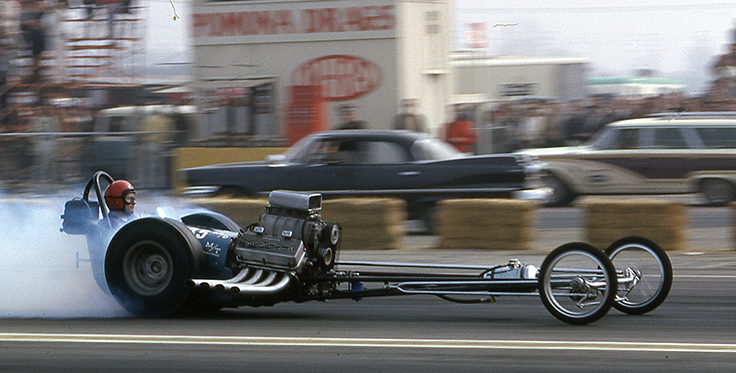
“In 1962, Dad started driving for Mickey Thompson. He drove for Mickey the full year and went on tour with four cars: Two Ivo cars like this one, one on nitro, one on gasoline, a twin-engine dragster, and a Hemi Pontiac that he won Indy with that year. The wedge [head] ran terribly, so they took a set of Hemi heads and they cast up a set of heads and machined them to fit the bolt pattern on the Pontiac, so it became a Hemi Pontiac.”

“Here’s the twin-engined car. The motor in the front is a Pontiac, and the one in the back is a Buick. You can see that the valve covers are different. They both have little 4-71 blowers on them.
“Here’s something that most people don’t know: Keith Black asked our dad to drive to the Greer-Black dragster before [Don] Prudhomme. My dad said no because he didn’t like Tommy Greer. I told ‘Snake’ that story, and he’d never heard that, but Ken Black was right there and verified it.’ "
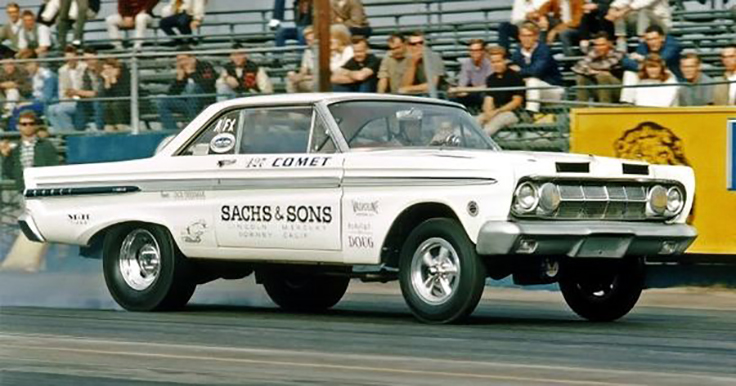
“We had two Sachs and Sons Comets. This is the first one that Fran Hernandez gave them. Dad quit driving dragsters when he got hurt in 1963, and then the factory gave him this A/FX car, but he didn’t like it because it was a stock car, so he hired Bill Shrewsberry to drive it. Ford asked what it would take for him to drive it, and he said, 'Put a blower and nitro on it,’ so a month or so later, they call him up and said, ‘Come and get your new car,’ which of course is the car that was the template for the nitro Funny Car. It wasn’t the first, but it was the most famous.”

“This is the blown car at Pomona the next year. He debuted it at Indy in 1964, and everyone went crazy, and we match raced it a lot. We knew we really had something because there would be 5,000 people at a match race with just him running because they didn't have anybody to race.”
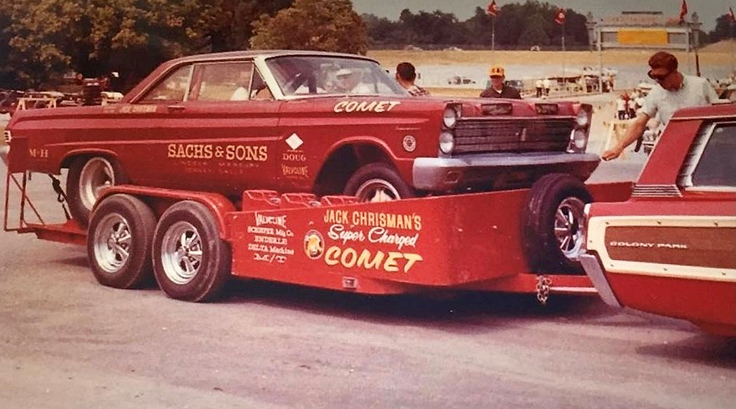
“They painted the car red the next year and went on tour with this station wagon. They didn't want it to look like it was a big high-dollar sponsor deal, so they just towed it on a trailer, and the factory liked it because everybody can see it on the road.”
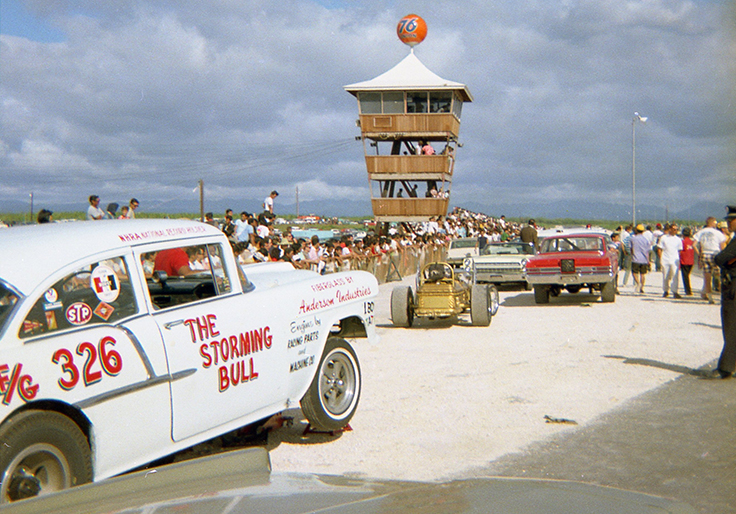
“The car event went to Hawaii — you can see it there in the staging lanes right ahead of the Dragula car that was on The Munsters TV show. They flew him and Shrewsberry over there — we even have a picture somewhere of Roland [Leong] standing next to him at the airport.
“I think they paid him 1,500 bucks to go there and put them up at the Kahala Hilton for a week and a half, and they shipped the car over. When they got the car off the boat, the longshoreman just pushed it with a forklift on the fiberglass bumpers. Ouch!”
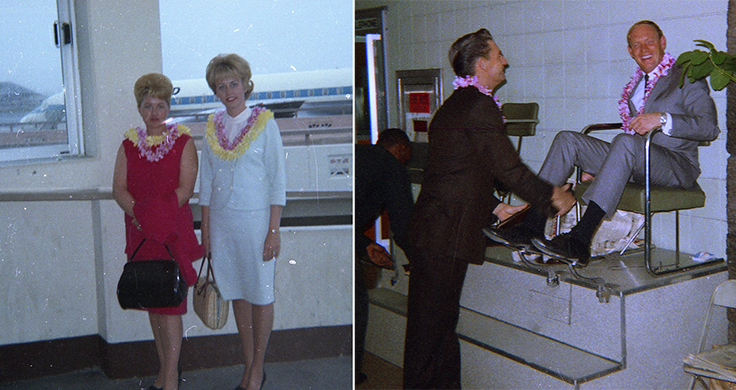
“That’s our mom and Shrewsberry's wife, Charlotte, at the airport and Dad acting like he was shining Shrewsberry’s shoes. They were real good friends.”

“That’s our mom, Dee, sitting in the ‘65 Comet. She never raced, except one time she won a Powder Puff race at Carlsbad, in like 1965 I think she beat Helen Sachs, who owned the Sachs & Sons dealership.”
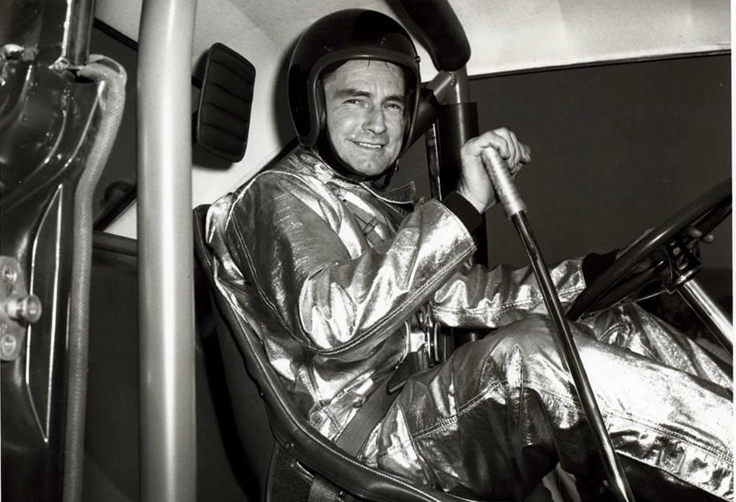
“This is Dad in the ‘65 Comet That's the brake handle. It was high-gear-only, but everybody thought he was shifting it because he had that big handle, but it was the brake.”
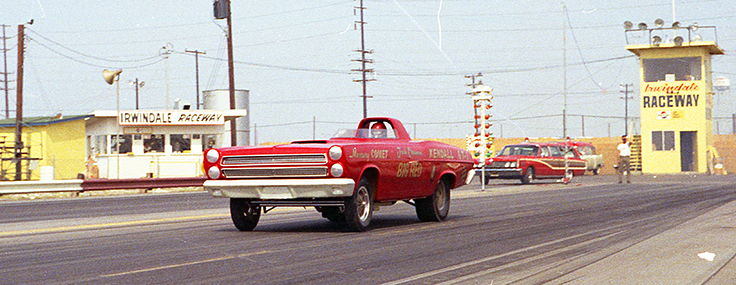
“So, in 1966, Dad got one of the first flip-top Mercury Comets. Don Nicholson got the first one, but his had a roof on it. Dad’s didn’t. When the car first came out, it wasn't in public yet, and Kendall Oil was the sponsor, and they called the car ‘Big Red,’ but then they found out later that Pure Oil or somebody had Big Red, so they had to take it off and had it lettered GT-1. This is Irwindale Raceway with that famous old hamburger stand.
“The Kendall deal was probably one of the first big sponsors. There was three cars getting sponsored, with Kendall, Autolite, and Air Lift. My dad had the first choice, and Kendall paid $15,000, so he took that. Autolite paid Nicholson $10,000, and Air Lift Rattler paid Schartman $8,500.”
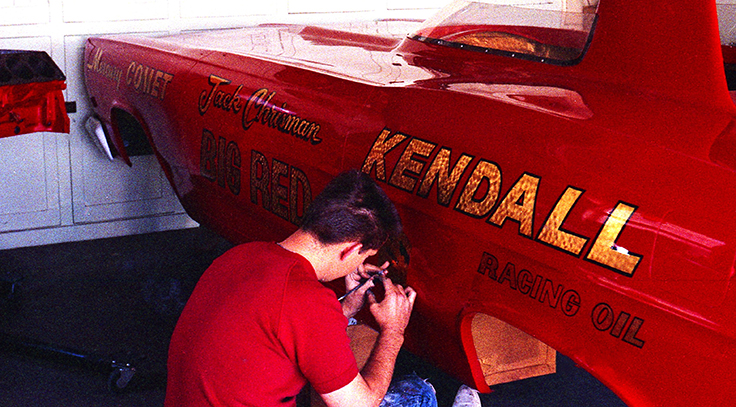
“Tom Kelly lettered the car at our house, and then he had to come back and take Big Red off of it, and he put GT one on the side. Tom was THE guy if you wanted a letterer. When some guys did the gold leaf, they used a cotton ball and twisted them to get a little to get the curlicue effect. Tom used to use a piece of velvet.”
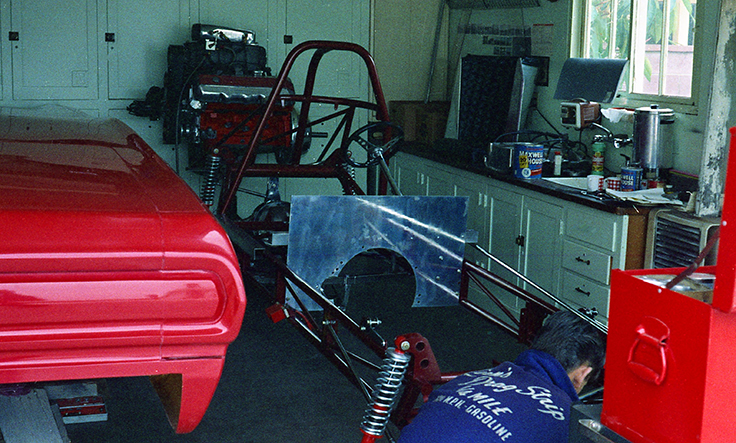
“Dad got the chassis from Logghe and painted the chassis and the body and everything out here. This is our little two-car garage. Everybody has a blown cammer in their garage, right?"
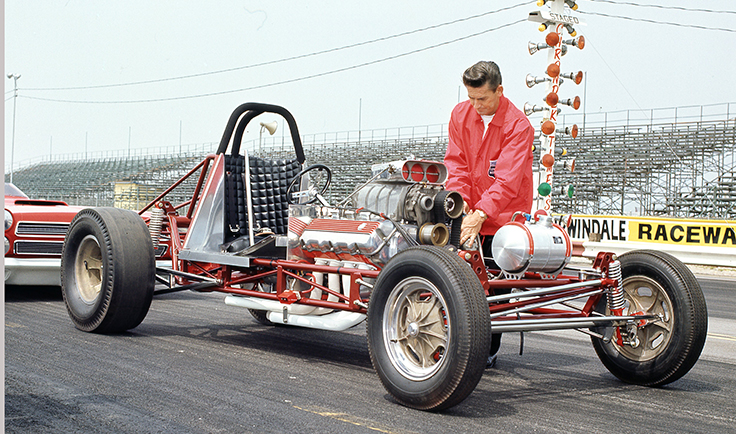
“Here’s the chassis and a good look at the roll cage, the front suspension, and the upholstery.”
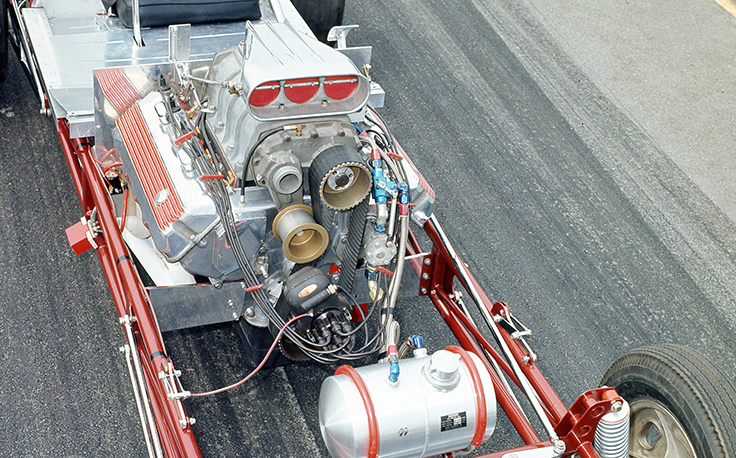
“Here’s the overhead cam Ford, with a 6-71 blower and an Enderle Bug Catcher injector. Looks like he’s got mag pulleys on the top and a mag idler on it. Note the tiny fuel tank. They had an Enderle 110 pump on it, which only pumped 13 gallons a minute.”
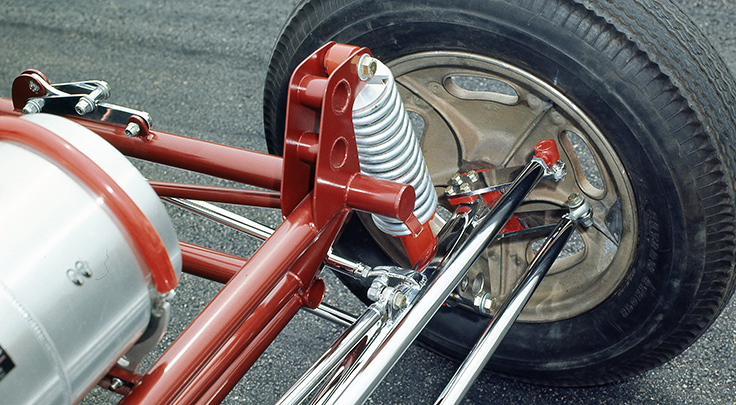
“On the first Logghe cars, the shock towers are welded. In 1967, they changed to an adjustable shock tower so you could move it up and down. That latch right above the fuel tank was how you locked the body down. The latch would grab something on the bulkhead, and then you pull the handle down, and that lets the body down. And then there's a bolt and a nut that you screw it on to the bulkhead. You had [to] reach inside where the car was running and latch it down and then put a bolt and nut on it. You started them with a body down because he didn't have blower starter yet, just starters on the flywheel that you plugged into a battery.”
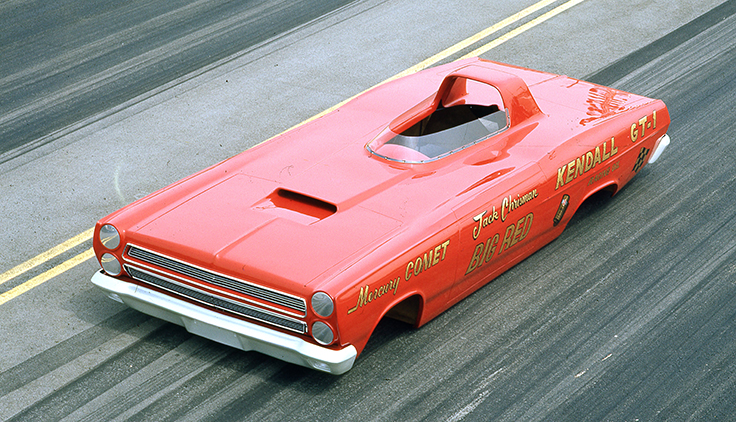
“The body was the identical size of a '66 Comet since it was common to take a splash of the stock car. Some racers would rent a car, take the chrome off, then take a mold off of that car, put the chrome back on, and then take the car back. We didn't have to because this was made at Ford Motor Company, and they had plenty of cars there.”
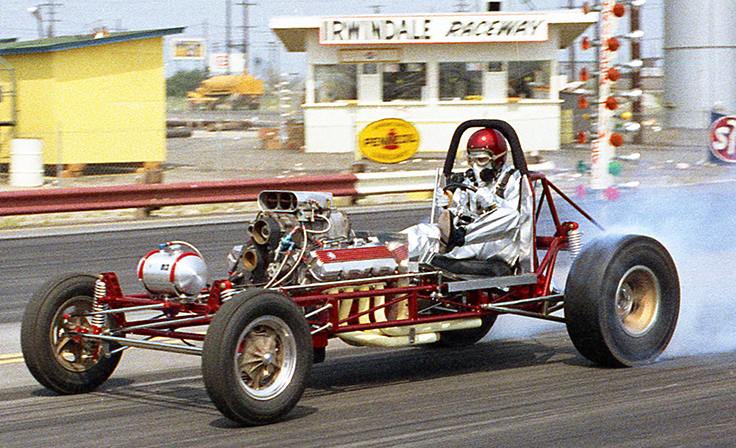
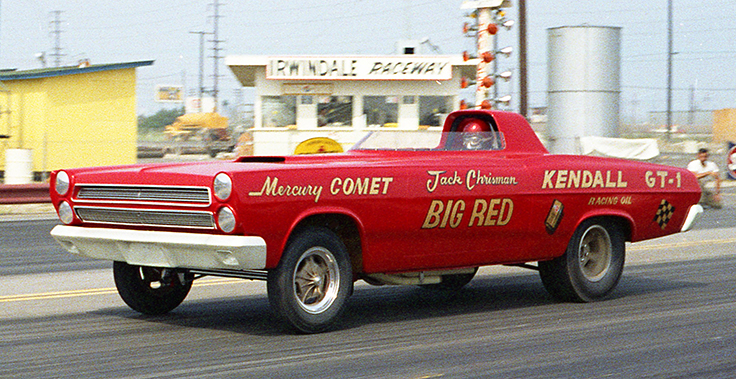
“Hot Rod magazine wanted to do a centerspread that was kind of like an x-ray of the car, so they made a bunch of runs with the body off and on. They tried to capture the car at the same spot on the track and use the negative or whatever to superimpose it on for you. So, you can see everything under the car with the body on.”
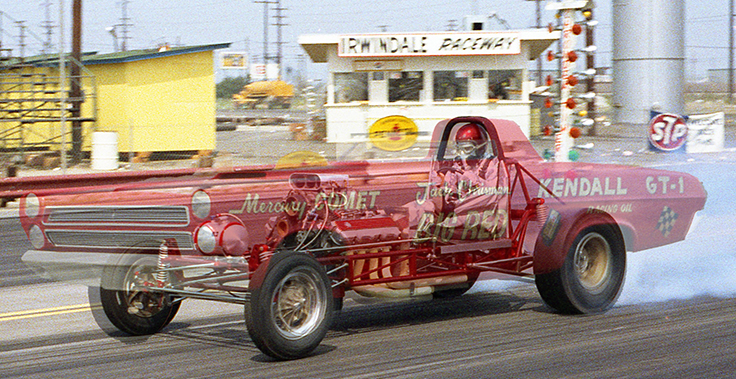
(Phil note: I couldn’t find the original Hot Rod image, so with PhotoShop I did in five minutes what it probably took Hot Rod photo editors hours to do in 1966..)
“One other thing to note about this is this is before they put a spoiler on the front. It started doing wheelstands at the finish line. [Kenny] Bernstein and those guys weren't the first in the Ford wind tunnel. In 1966, they took the Ford wind tunnel [and] came up with a front spoiler. My dad had the full width, and Nicholson and Schartman got a half width because they had windshields and they didn't need it.
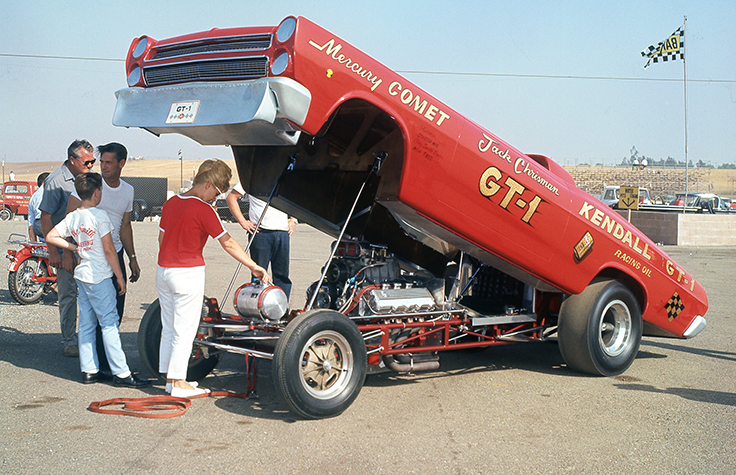
“This is after they painted the GT 1 on it and the bigger front spoiler. I think this is at Riverside, where he won the Hot Rod magazine race and beat Jim Liberman in Lew Arrington's car in the final. This car ran almost 190 mph but only lasted about four months. He crashed it in New York. It was rainy and the chutes didn't come out.”

“This is the 1967 car. They finally got better tires on them, that's when they started hauling ass. The fast guys were injected in '66 and '67, and then the blown cars were running like eight-flat, 8.10. When my dad went to Indy in '67, Marvin Rifchin [of M&H Tires] asked my dad if he would put his new tires on the car. My dad had a deal through the factory for Goodyear, but Marvin had always been good to him, so he put them on, and he went from like an 8.05 or something to 7.60. After that, you couldn’t believe how long the line was at the M&H tent. The wheelie bars are old leaf springs turned upside down with casters on them.”
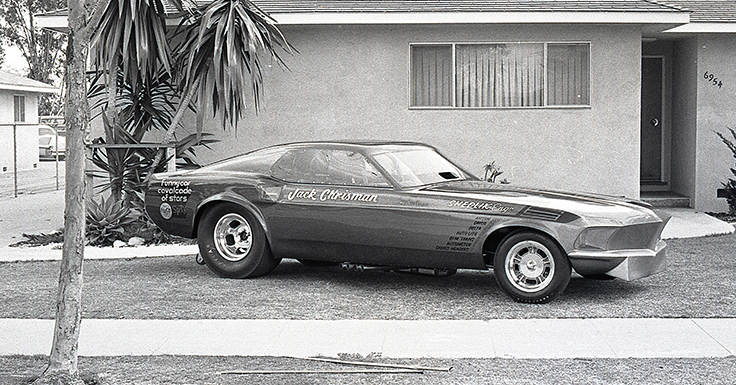
"This is 1969. Getting ready to go on tour, shot in front of my mom and dad's house in North Long Beach, where we grew up. Because everybody has a Funny Car in their front yard, right? The car was beautiful. It started out persimmon in the front, and it blended all the way back to a dark maroon."
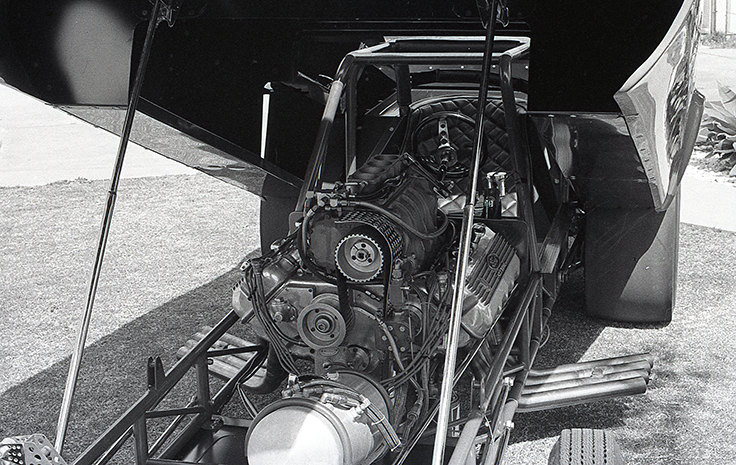
“This is still a cammer and look at the weed burner headers before zoomies.”

“That is Lions Dragstrip at the end of 1969 with the Mustang.. We just got off a tour with the Coke circuit [Coca-Cola Cavalcade of Stars] and had a big blower explosion and blew the roof off. You can see C.J. Hart at far right. My dad was the captain of the Coke circuit the first year, and there were eight guys on tour, and they raced each other like 40 times that year. He had just sold this car to Frank Oglesby, and then Frank called and said, 'I'm almost there; how does my car look?' Dad was like, 'Well, you're not gonna like it. We’ve got to do a little bodywork.' So, he took over to Marv Eldridge, and they put a new top on it."

“Look at that blower with a big crack in the case. It was a big explosion.”

“This is his final car, the rear-engined sidewinder Funny Car that became John Force's first Funny Car. This was a cover shoot for the cover of Hot Rod."
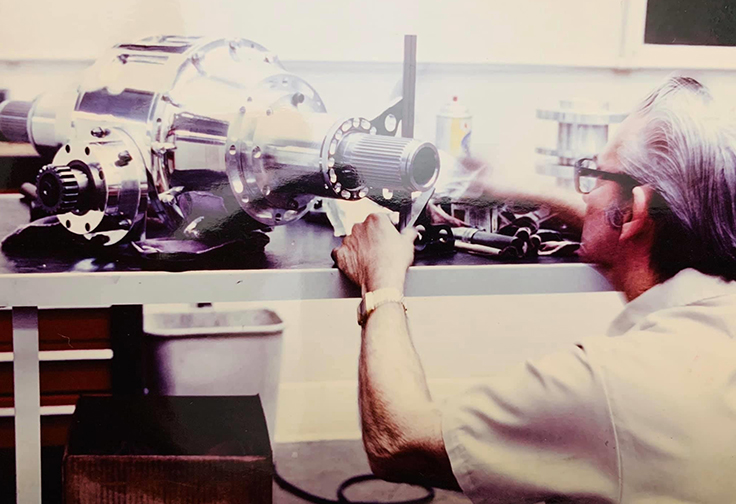
“Our dad started Jack Chrisman Enterprises in 1972 to build rear ends. This is either Larry Minor's or Joe Amato's rear end, which were the first live-axle rear ends we made. He was done racing, and he needed to make a living.
“When he started selling all his race-car stuff, he had about eight or 10 rear ends he sold to people, then they would bring them back. 'Can you set this up for me? We don't know how,' and he just started saying, 'I'm gonna start charging you guys.' People were bringing their rear ends over to the shop anyways, and he just started doing rear-end work for his buddies.”
The Chrisman legacy did not die with Jack in 1989. Steve went on to drive alcohol and nitro Funny Cars and Top Fuelers, and Lana was a big part of the rear-end business. Jerry Toliver, son of Art’s sister Juanita, competed in Funny Car in the 1990s and 2000s, winning five NHRA national events. Lana’s daughter, Shelby Chrisman, got her Super Comp license in 2017, and Lloyd’s grandsons, Kelly and Carey Chrisman, currently race off-road trophy trucks.

“Dad was alive long enough to see me drive,” said Steve. “He could have driven my car. He was only 53 or 54 at the time. I kick myself in the ass because it never even entered my mind when I had my alcohol car. But people still remember him.
“Every time I'd make a pass and like my dragsters or [Del] Worsham’s car, the announcer would say, 'That’s the son of Jack Chrisman,' and people ask me if get tired of hearing that. No, no, not at all.
“My dad and Wally Parks were really, really good friends. Every time I'd run my car, Wally would come over and ask how I was doing, how my mom and dad were doing.
“Fans come up and say, ‘I remember this’ or 'I remember that’ about my dad, which is cool. It was funny because the first run that Lana’s daughter made at the [Frank] Hawley School, she ran 8.55, and I told her, ‘Shelby, you just ran four tenths quicker than your grandpa did when he won the first Winternationals.’ It’s great that we still have such close touch with the sport and people in it who appreciate what my dad and Art did.”
Phil Burgess can be reached at pburgess@nhra.com
Hundreds of more articles like this can be found in the DRAGSTER INSIDER COLUMN ARCHIVE
Or try the Random Dragster Insider story generator



















































